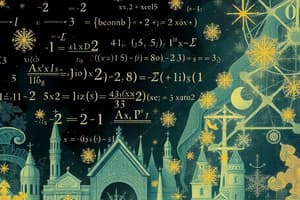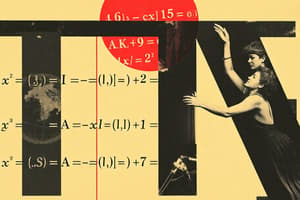Podcast
Questions and Answers
What is a symbol that represents an unknown quantity called in algebra?
What is a symbol that represents an unknown quantity called in algebra?
Variable
What is a fixed numerical value in an algebraic expression called?
What is a fixed numerical value in an algebraic expression called?
Constant
What mathematical symbol indicates that two expressions are equal?
What mathematical symbol indicates that two expressions are equal?
Equals sign (=)
What is an equation where the highest power of the variable is 1 called?
What is an equation where the highest power of the variable is 1 called?
What is a set of two or more linear equations with the same variables called?
What is a set of two or more linear equations with the same variables called?
What is a statement that compares two expressions using symbols like < or > called?
What is a statement that compares two expressions using symbols like < or > called?
What is an expression consisting of variables and coefficients, involving only addition, subtraction, and multiplication, and non-negative integer exponents called?
What is an expression consisting of variables and coefficients, involving only addition, subtraction, and multiplication, and non-negative integer exponents called?
What is the highest power of the variable in a polynomial called?
What is the highest power of the variable in a polynomial called?
What is the process of expressing a polynomial as a product of simpler polynomials called?
What is the process of expressing a polynomial as a product of simpler polynomials called?
What is a polynomial equation of degree 2 called?
What is a polynomial equation of degree 2 called?
Write the quadratic formula.
Write the quadratic formula.
What is a relation between a set of inputs and a set of possible outputs where each input is related to exactly one output called?
What is a relation between a set of inputs and a set of possible outputs where each input is related to exactly one output called?
For the function $f(x) = mx + b$, what is 'm' called?
For the function $f(x) = mx + b$, what is 'm' called?
What is the set of all possible input values of a function called?
What is the set of all possible input values of a function called?
What is the repeated multiplication of a number called?
What is the repeated multiplication of a number called?
What is the number that is multiplied by itself when raising to a power called?
What is the number that is multiplied by itself when raising to a power called?
What is the inverse operation of exponentiation called?
What is the inverse operation of exponentiation called?
What is the rule that states $a^m * a^n = a^(m+n)$ called?
What is the rule that states $a^m * a^n = a^(m+n)$ called?
What is the rule that states $(a^m)^n = a^(m*n)$ called?
What is the rule that states $(a^m)^n = a^(m*n)$ called?
What is the rule that states $a^{-n} = 1 / a^n$ called?
What is the rule that states $a^{-n} = 1 / a^n$ called?
What is the rule that states $a^0 = 1$ called (when a ≠ 0)?
What is the rule that states $a^0 = 1$ called (when a ≠ 0)?
What is the process of eliminating radicals from the denominator of a fraction called?
What is the process of eliminating radicals from the denominator of a fraction called?
What is the inverse operation to exponentiation?
What is the inverse operation to exponentiation?
What does $log_b(x) = y$ mean?
What does $log_b(x) = y$ mean?
What is the rule that states $log_b(mn) = log_b(m) + log_b(n)$ called?
What is the rule that states $log_b(mn) = log_b(m) + log_b(n)$ called?
What is the rule that states $log_b(m^p) = p * log_b(m)$ called?
What is the rule that states $log_b(m^p) = p * log_b(m)$ called?
What is the formula that allows you to change the base of a logarithm called?
What is the formula that allows you to change the base of a logarithm called?
What are numbers of the form a + bi, where a and b are real numbers and i is the imaginary unit, called?
What are numbers of the form a + bi, where a and b are real numbers and i is the imaginary unit, called?
In a complex number a + bi, what is 'a' called?
In a complex number a + bi, what is 'a' called?
What is the value of $i^2$?
What is the value of $i^2$?
What is simplifying both sides by combining like terms the first step to?
What is simplifying both sides by combining like terms the first step to?
What does isolating the variable by using inverse operations help you to do?
What does isolating the variable by using inverse operations help you to do?
What are 'x' and 'y' values that fall on the line when graphing linear equations?
What are 'x' and 'y' values that fall on the line when graphing linear equations?
What is it called when you solve one equation for one variable and substitute that expression into the other equation?
What is it called when you solve one equation for one variable and substitute that expression into the other equation?
What is it called when you add or subtract multiples of the equations to eliminate one variable?
What is it called when you add or subtract multiples of the equations to eliminate one variable?
Flashcards
What is Algebra?
What is Algebra?
Deals with symbols and rules to manipulate them, representing quantities without fixed values.
What are variables?
What are variables?
Symbols, usually letters, representing unknown or changing values.
What are constants?
What are constants?
Fixed numerical values in an expression.
What are algebraic expressions?
What are algebraic expressions?
Signup and view all the flashcards
What is an equation?
What is an equation?
Signup and view all the flashcards
What is solving equations?
What is solving equations?
Signup and view all the flashcards
What is a linear equation?
What is a linear equation?
Signup and view all the flashcards
How to solve linear equations?
How to solve linear equations?
Signup and view all the flashcards
What are systems of linear equations?
What are systems of linear equations?
Signup and view all the flashcards
What is substitution method?
What is substitution method?
Signup and view all the flashcards
What is elimination method?
What is elimination method?
Signup and view all the flashcards
What is an inequality?
What is an inequality?
Signup and view all the flashcards
What is a polynomial?
What is a polynomial?
Signup and view all the flashcards
What is factoring polynomials?
What is factoring polynomials?
Signup and view all the flashcards
What is a quadratic equation?
What is a quadratic equation?
Signup and view all the flashcards
What is the quadratic formula?
What is the quadratic formula?
Signup and view all the flashcards
What is a function?
What is a function?
Signup and view all the flashcards
What are linear functions?
What are linear functions?
Signup and view all the flashcards
What is the domain?
What is the domain?
Signup and view all the flashcards
What is the range?
What is the range?
Signup and view all the flashcards
What are exponents?
What are exponents?
Signup and view all the flashcards
Product of Powers Rule
Product of Powers Rule
Signup and view all the flashcards
Quotient of Powers Rule
Quotient of Powers Rule
Signup and view all the flashcards
Power of a Power Rule
Power of a Power Rule
Signup and view all the flashcards
Negative Exponent Rule
Negative Exponent Rule
Signup and view all the flashcards
How to simplify radicals?
How to simplify radicals?
Signup and view all the flashcards
What is a logarithm?
What is a logarithm?
Signup and view all the flashcards
Product Rule of Logarithms
Product Rule of Logarithms
Signup and view all the flashcards
Quotient Rule of Logarithms
Quotient Rule of Logarithms
Signup and view all the flashcards
What are complex numbers?
What are complex numbers?
Signup and view all the flashcards
Study Notes
- Algebra is a branch of mathematics that deals with symbols and the rules for manipulating those symbols
- These symbols represent quantities without fixed values, known as variables
- Algebra is fundamental to nearly all other areas of mathematics, science, and engineering
Basic Operations
- Algebraic expressions use basic arithmetic operations: addition, subtraction, multiplication, and division
- These operations are performed on both constants (numbers) and variables (symbols representing numbers)
- Exponents indicate repeated multiplication
Variables and Constants
- Variables are symbols, usually letters, that represent unknown or changing quantities
- Constants are fixed numerical values
- In the expression "3x + 5", 'x' is the variable, and 3 and 5 are constants
Algebraic Expressions
- Algebraic expressions combine variables, constants, and operations
- Examples include 5x, 2y + 3, and a^2 - 4ab + b^2
- Terms are parts of an expression separated by addition or subtraction
Equations
- An equation is a statement that asserts the equality of two expressions
- It contains an equals sign (=)
- The goal is often to find the value(s) of the variable(s) that make the equation true (solving the equation)
- Example: x + 5 = 10
Solving Equations
- Solving equations involves isolating the variable on one side of the equation
- This is done by performing the same operations on both sides of the equation to maintain equality
- Basic techniques include adding, subtracting, multiplying, or dividing both sides by the same value.
- Inverse operations are used to isolate variables
Linear Equations
- A linear equation is an equation where the highest power of the variable is 1
- It can be written in the form ax + b = 0, where a and b are constants and x is the variable
- The graph of a linear equation is a straight line
Solving Linear Equations
- To solve a linear equation, simplify both sides by combining like terms
- Then, isolate the variable by using inverse operations
- Example: To solve 2x + 3 = 7, subtract 3 from both sides (2x = 4), then divide by 2 (x = 2)
Systems of Linear Equations
- A system of linear equations is a set of two or more linear equations with the same variables
- The solution to a system is the set of values for the variables that satisfy all equations simultaneously
- Systems can have one solution, no solution, or infinitely many solutions
Methods for Solving Systems
- Substitution: Solve one equation for one variable, then substitute that expression into the other equation
- Elimination: Add or subtract multiples of the equations to eliminate one variable
- Graphing: Graph each equation and find the point(s) of intersection, which represent the solution(s)
Inequalities
- An inequality is a statement that compares two expressions using inequality symbols (<, >, ≤, ≥)
- Solving inequalities involves similar techniques to solving equations, but with some key differences
- Multiplying or dividing by a negative number reverses the inequality sign
Graphing Inequalities
- Inequalities can be graphed on a number line or in a coordinate plane
- For one-variable inequalities, use a number line with open or closed circles to indicate whether the endpoint is included
- For two-variable inequalities, graph the boundary line and shade the region that satisfies the inequality
Polynomials
- A polynomial is an expression consisting of variables and coefficients, involving only the operations of addition, subtraction, multiplication, and non-negative integer exponents
- Examples: x^2 + 3x - 4, 5y^3 - 2y + 1
- Polynomials are classified by their degree (the highest power of the variable) and number of terms
Operations with Polynomials
- Polynomials can be added, subtracted, multiplied, and divided
- Addition and subtraction involve combining like terms
- Multiplication involves using the distributive property
- Division can be done using long division or synthetic division
Factoring Polynomials
- Factoring is the process of expressing a polynomial as a product of simpler polynomials
- Common techniques include factoring out a greatest common factor (GCF), using difference of squares, perfect square trinomials, and grouping
Quadratic Equations
- A quadratic equation is a polynomial equation of degree 2
- The general form is ax^2 + bx + c = 0, where a, b, and c are constants and a ≠ 0
- Quadratic equations can have two, one, or no real solutions
Solving Quadratic Equations
- Factoring: Factor the quadratic expression and set each factor equal to zero
- Quadratic Formula: Use the formula x = (-b ± √(b^2 - 4ac)) / (2a) to find the solutions
- Completing the Square: Rewrite the equation in the form (x + p)^2 = q and then solve for x
Functions
- A function is a relation between a set of inputs (domain) and a set of possible outputs (range) where each input is related to exactly one output
- Functions are often denoted as f(x), where x is the input and f(x) is the corresponding output
Types of Functions
- Linear Functions: f(x) = mx + b, where m is the slope and b is the y-intercept
- Quadratic Functions: f(x) = ax^2 + bx + c, whose graph is a parabola
- Exponential Functions: f(x) = a^x, where a is a constant
- Logarithmic Functions: f(x) = log_a(x), the inverse of exponential functions
Graphing Functions
- Functions can be graphed on a coordinate plane by plotting points (x, f(x))
- The graph provides a visual representation of the function's behavior
- Key features to identify include intercepts, slope, vertex (for quadratics), and asymptotes
Domain and Range
- The domain of a function is the set of all possible input values (x-values)
- The range of a function is the set of all possible output values (f(x)-values)
- Domain and range can be restricted by the function's equation or context
Exponents and Radicals
- Exponents indicate repeated multiplication
- Radicals (roots) are the inverse operation of exponentiation
- Understanding exponent rules is crucial for simplifying expressions
Rules of Exponents
- Product of Powers: a^m * a^n = a^(m+n)
- Quotient of Powers: a^m / a^n = a^(m-n)
- Power of a Power: (a^m)^n = a^(m*n)
- Power of a Product: (ab)^n = a^n * b^n
- Power of a Quotient: (a/b)^n = a^n / b^n
- Negative Exponent: a^(-n) = 1 / a^n
- Zero Exponent: a^0 = 1 (if a ≠ 0)
Simplifying Radicals
- Radicals can be simplified by factoring out perfect squares (or cubes, etc.) from the radicand
- Example: √20 = √(4 * 5) = √4 * √5 = 2√5
Rationalizing Denominators
- Rationalizing the denominator involves eliminating radicals from the denominator of a fraction
- Multiply the numerator and denominator by a suitable expression that will eliminate the radical in the denominator
Logarithms
- A logarithm is the inverse operation to exponentiation
- log_b(x) = y means b^y = x, where b is the base, x is the argument, and y is the exponent
Properties of Logarithms
- Product Rule: log_b(mn) = log_b(m) + log_b(n)
- Quotient Rule: log_b(m/n) = log_b(m) - log_b(n)
- Power Rule: log_b(m^p) = p * log_b(m)
- Change of Base Formula: log_a(x) = log_b(x) / log_b(a)
Solving Exponential and Logarithmic Equations
- Exponential equations can often be solved by taking the logarithm of both sides
- Logarithmic equations can be solved by exponentiating both sides
Complex Numbers
- Complex numbers are numbers of the form a + bi, where a and b are real numbers, and i is the imaginary unit (i^2 = -1)
- 'a' is the real part, and 'b' is the imaginary part
Operations with Complex Numbers
- Addition/Subtraction: (a + bi) ± (c + di) = (a ± c) + (b ± d)i
- Multiplication: (a + bi)(c + di) = (ac - bd) + (ad + bc)i
- Division: Multiply the numerator and denominator by the conjugate of the denominator
Studying That Suits You
Use AI to generate personalized quizzes and flashcards to suit your learning preferences.




